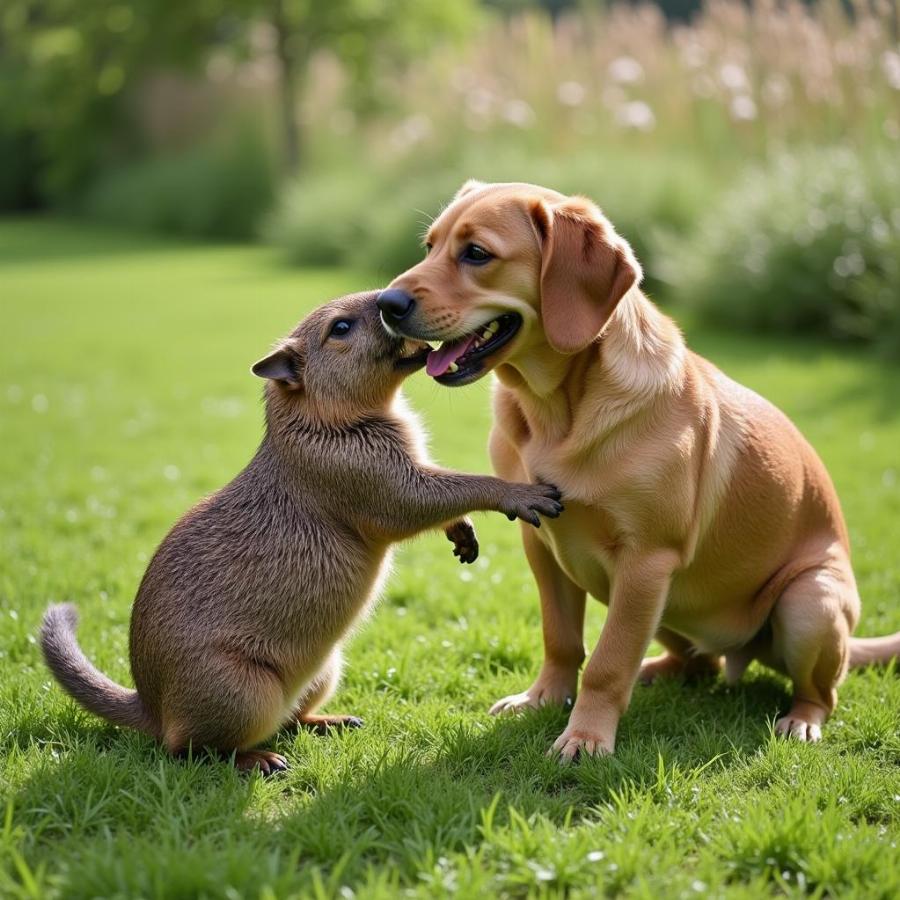Capybara and dog interactions have become increasingly popular online, sparking curiosity about the possibility of these two very different species coexisting peacefully. Can these giant rodents and our beloved canine companions truly be friends? This article delves into the dynamics of capybara and dog relationships, exploring the potential benefits and challenges, and offering guidance for those considering introducing these two species.  Capybara và chó chơi đùa cùng nhau
Capybara và chó chơi đùa cùng nhau
Understanding the Capybara’s Nature
Capybaras, the world’s largest rodents, are known for their social and generally docile nature. They are semi-aquatic, originating from South America, and thrive in environments with access to water. Their inherent calmness and herd mentality often make them surprisingly adaptable to interacting with other species, including dogs. However, it’s crucial to remember that every capybara is an individual, and their reactions to dogs can vary.
Can a Capybara Live with a Dog?
While some capybaras and dogs can form heartwarming bonds, cohabitation presents unique challenges. The sheer size difference can pose a risk, especially with smaller dog breeds. A playful nip from a capybara, harmless amongst their own kind, could be significantly more impactful on a smaller dog. Furthermore, capybaras have specific dietary and environmental needs that must be met to ensure their well-being. Providing ample space, access to water for swimming, and a diet rich in grass and aquatic vegetation is essential. These needs may not be easily compatible with a typical dog-friendly home environment.
Introducing a Capybara and a Dog
Introducing a capybara and a dog requires careful planning, patience, and close supervision. Start with short, supervised interactions in a neutral territory. Observe both animals’ body language closely. Signs of stress or aggression in either animal should be taken seriously, and the interaction should be stopped immediately.
Ensuring a Harmonious Relationship
A successful capybara-dog relationship relies on mutual respect and understanding. Training plays a vital role in this process. A well-trained dog, accustomed to respecting boundaries and responding to commands, is more likely to interact appropriately with a capybara. Likewise, it’s important to socialize the capybara from a young age, exposing them to a variety of sights, sounds, and experiences, including dogs. This early socialization can help them adapt more readily to the presence of a canine companion.
Potential Benefits and Risks
The potential benefits of a positive capybara-dog relationship include companionship and enrichment for both animals. Seeing these unlikely friends interact can be incredibly rewarding for owners as well. However, it’s essential to acknowledge the inherent risks. Capybaras, despite their gentle nature, are still wild animals with powerful instincts. south american bush dog Even seemingly playful interactions can unintentionally lead to injury if not carefully managed. Differences in communication styles can also lead to misunderstandings, potentially resulting in conflict.
Is it Right for You?
Ultimately, the decision of whether or not to introduce a capybara and a dog rests on careful consideration of the individual animals, the owner’s experience and resources, and the commitment to ensuring the well-being of both species. It’s a decision that should not be taken lightly and requires extensive research, preparation, and ongoing dedication.
Conclusion
The captivating image of a capybara and dog friendship can be alluring, but the reality is far more complex. While these two species can coexist peacefully and even form bonds under the right circumstances, it requires careful planning, dedicated training, and constant vigilance. Understanding the unique needs and potential risks associated with this unusual pairing is crucial for anyone considering bringing a capybara and a dog together. Remember, the well-being of both animals should always be the top priority.
FAQ
-
Are capybaras legal to own as pets? The legality of owning a capybara varies depending on local and state regulations. It’s crucial to research and comply with all applicable laws before acquiring a capybara.
-
What kind of dog is best suited for interacting with a capybara? Calm, well-trained dogs with a gentle temperament are generally better suited for interacting with capybaras.
-
What are the signs of stress in a capybara? Signs of stress in a capybara can include excessive hiding, vocalizations, and changes in eating habits.
-
How much space does a capybara need? Capybaras require a significant amount of space, including access to a large water source for swimming.
-
What should I feed my capybara? Capybaras primarily eat grass and aquatic vegetation.
-
Can capybaras be trained? While not as easily trained as dogs, capybaras can be socialized and learn to respond to basic commands.
-
What are the risks of introducing a capybara to a dog? Risks include potential injury due to size differences, misunderstandings in communication, and the transmission of diseases.
Do you have any other questions about exotic pets? Check out our article on south american bush dog
Beaut Dogs is your trusted source for all things canine, offering comprehensive and reliable information on the world of dogs. From breed characteristics to care guides, Beaut Dogs helps you navigate the joys and responsibilities of dog ownership. For personalized advice and expert guidance, contact us at [email protected]. We’re here to help you and your furry friend thrive.